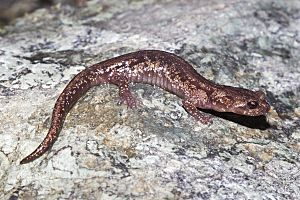Clouded salamander facts for kids
Quick facts for kids Clouded salamander |
|
|---|---|
 |
|
| Conservation status | |
| Scientific classification |
The clouded salamander (Aneides ferreus) is a type of salamander that lives in the Pacific Northwest region. It belongs to a family called Plethodontidae, which are salamanders without lungs. These salamanders breathe through their skin and the lining of their mouths. Clouded salamanders usually live in cool, wet forests. They might even build their nests in trees! Sadly, their homes are shrinking because of habitat loss.
Contents
What Does a Clouded Salamander Look Like?
The clouded salamander is a long, thin creature. It can grow to about 5 inches (130 mm) (12.7 cm) long from its nose to the tip of its tail. It has fairly long legs and toes with square tips. Its tail can even grip things, like a monkey's tail!
This salamander has special grooves on its face. Two small lines connect its nostrils to its mouth. It also has sixteen grooves along its sides, called costal grooves. These grooves help it move and breathe.
The top of its body is usually light grey. It often has patches of gold, olive green, or dull red. Young clouded salamanders look a bit different. They have a shiny, brass-colored stripe running down the middle of their back.
Where Do Clouded Salamanders Live?
Clouded salamanders live in the Cascadian region of North America. This area includes parts of the Columbia River south through the Cascade Mountains. You can also find them along the Oregon coast. Their range extends to the northern tip of California in Del Norte County. They can live at high places, up to about 1,700 metres (5,600 ft) (5,577 feet) above sea level.
These salamanders prefer forests that are moist. They like areas with fewer trees rather than very thick, dry forests. They often hide under logs and rocks. You can also find them under loose tree bark or inside rotting logs. They love to hide in cracks in rocks and piles of loose stones. They especially like rotting Douglas-fir logs. You might even see them in areas where trees have recently been cut down, among the stumps and wood pieces.
What Do Clouded Salamanders Eat and How Do They Grow?
Clouded salamanders are carnivores, meaning they eat other small creatures. Their diet mainly includes small invertebrates. They often munch on woodlice, ants, and beetles. They also eat flies, termites, mites, centipedes, millipedes, spiders, and even tiny pseudoscorpions.
Breeding usually happens in June and July. Female salamanders lay about nine to seventeen eggs at a time. They often lay their eggs in small chambers. These chambers are usually dug out inside rotting logs.
A cool fact about these salamanders is how their young develop. The baby salamanders grow inside the eggs. They don't have a free-swimming larval stage like some other amphibians. Instead, they hatch as tiny juveniles after about two months. One or both parents might stay with the eggs. They protect them until the babies hatch.
Are Clouded Salamanders in Danger?
The clouded salamander is currently listed as "least concern" on the IUCN Red List of Threatened Species. This means they are not in immediate danger of disappearing. However, their numbers might be going down.
Their favorite hiding spots, like tree stumps and decaying wood, are changing. This is happening because of new ways people manage forests. But there's good news! Plans to protect other animals, like the spotted owl (Strix occidentalis) and the marbled murrelet (Brachyramphus marmorlet), might help. These conservation efforts could also help protect the clouded salamander's home. This would help keep their population healthy.
See also
 In Spanish: Aneides ferreus para niños
In Spanish: Aneides ferreus para niños


